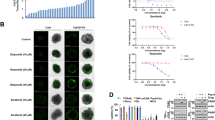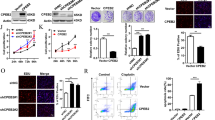Abstract
Invasion and metastasis of certain tumors are accompanied by increased mRNA protein levels and enzymatic activity of cathepsin L. Cathepsin L has also been suggested to play a role in the proteolytic cascades associated with apoptosis. To investigate the role of cathepsin L in brain tumor invasion and apoptosis, the human glioma cell line, IPTP, was stably transfected with full-length antisense and sense cDNA of cathepsin L. Down-regulation of cathepsin L by antisense cDNA significantly impaired (up to 70%) glioma cell invasion in vitro and markedly increased glioma cell apoptosis induced by staurosporine. Compared to control and parental cell lines, antisense down-regulation of cathepsin L was associated with an earlier induction of caspase-3 activity. Up-regulation of cathepsin L activity by sense cDNA was associated with reduced apoptosis and later induction of caspase-3 activity. Moreover, down-regulation of cathepsin L lowered the expression of antiapoptotic protein Bcl-2, whereas up-regulation increased the expression of Bcl-2, indicating that cathepsin L acts upstream of caspase-3. These data show that cathepsin L is an important protein mediating the malignancy of gliomas and its inhibition may diminish their invasion and lead to increased tumor cell apoptosis by reducing apoptotic threshold.
This is a preview of subscription content, access via your institution
Access options
Subscribe to this journal
Receive 12 print issues and online access
$259.00 per year
only $21.58 per issue
Buy this article
- Purchase on Springer Link
- Instant access to full article PDF
Prices may be subject to local taxes which are calculated during checkout








Similar content being viewed by others
References
Turk B, Turk D, Turk V . Lysosomal cysteine proteases: more than scavengers. Biochim Biophys Acta. 2000;1477:98–111.
Koblinski JE, Sloane BF . Is altered localization of cathepsin B casually related to malignant progression? In: N Katunuma, ed. Medical Aspects of Proteinases and Proteinase Inhibitors, Tokyo, Japan: IOS Press; 1997:185–194.
Demchik LL, Sameni M, Nelson K, et al. Cathepsin B and glioma invasion. Int J Dev Neurosci. 1999;17:483–494.
Pilkington GJ . Tumour cell migration in the CNS. Brain Pathol. 1994;4:157–166.
Gladson CL . The extracellular matrix of gliomas: modulation of cell function. J Neuropathol Exp Neurol. 1999;58:1029–1040.
Schmitt M, Janicke F, Graeff F . Tumour-associated proteases. Fibrinolysis. 1992;6:3–26.
Levičar N, Strojnik T, Kos J, et al. Lysosomal enzymes, cathepsins in glioma invasion. J Neuro-Oncol. 2002;58:21–32.
Strojnik T, Kos J, Židanik B, et al. Cathepsin B immunohistochemical staining in tumour and endothelial cells is a new prognostic factor for survival in patients with brain tumors. Clin Cancer Res. 1999;5:559–567.
Sivaparvathi M, Yamamoto M, Nicolson GL, et al. Expression and immunohistochemical localization of cathepsin L during the progression of human gliomas. Clin Exp Metastasis. 1996;14:27–34.
Lah TT, Strojnik T, Levičar N, et al. Clinical and experimental studies of cysteine cathepsins and their inhibitors in human brain tumors. Int J Biol Markers. 2000;15:90–93.
Thompson C . Apoptosis in the pathogenesis and treatment of disease. Science. 1995;267:1456–1462.
Jaattela M . Escaping cell death: survival proteins in cancer — review. Exp Cell Res. 1999;248:30–43.
Scaffidi C, Fulda S, Srinivasan A, et al. Two CD95 (APO-1/Fas) signaling pathways. EMBO J. 1998;17:1675–1687.
Adams JM, Cory S . The Bcl-2 protein family: arbiters of cell survival. Science. 1998;281:1322–1326.
Kroemer G . The proto-oncogene Bcl-2 and its role in regulating apoptosis. Nat Med. 1997;3:934
Zhao M, Eaton JW, Brunk UT . Protection against oxidant-mediated lysosomal rupture: a new anti-apoptotic activity of Bcl-2. FEBS Lett. 2000;485:104–108.
Kidd VJ, Lahti JM, Teitz T . Proteolytic degradation of apoptosis. Semin Cell Dev Biol. 2000;11:191–201.
Stoka V, Turk B, Schendel SL, et al. Lysosomal protease pathway to apoptosis. J Biol Chem. 2001;276:3149–3157.
Katunuma N, Matsui A, Le QT, et al. Novel procaspase-3 activating cascade mediated by lysoapoptases and its biological significances in apoptosis. Adv Enzyme Regul. 2001;41:237–250.
Kin Y, Chintala SK, Go Y, et al. A novel role for urokinase-type plasminogen activator receptor in apoptosis of malignant gliomas. Int J Oncol. 2000;17:61–65.
Castro MG, Rowe J, Morrison E, et al. Calcium-phosphate, DEAE–dextran coprecipitation, and electroporation to transfer genes into neuronal and glial cell lines. In: Lowenstein PR, Enquist LW, eds. Protocols for Gene Transfer in Neuroscience: Towards Gene Therapy of Neurological Disorders. New York: Wiley; 1996:9–23.
Werle B, Staib A, Julke B, et al. Fluorimetric microassays for the determination of cathepsin L and cathepsin S activities. Biol Chem. 1999;380:1109–1116.
Holst-Hansen C, Johannessen B, Hoyer-Hansen G, et al. Urokinase-type plasminogen activation in three human breast cancer cell lines correlates with their in vitro invasiveness. Clin Exp Metastasis. 1996;14:297–307.
Duke RC, Cohen JJ . Morphological and biochemical assays of apoptosis. In: Coligan JE, Kruisbeak AM, eds. Current Protocols in Immunology. New York: Wiley; 1992. 3–17.
Nicolleti I, Migliorati G, Pagliacci MC, et al. A rapid and simple method for measuring thymocyte apoptosis by propidium iodide staining and flow cytometry. J Immunol Methods. 1991;139:271–279.
Thornberry NA, Bull HG, Calaycay JR, et al. A novel heterodimeric cysteine protease is required for interleukin-1 beta processing in monocytes. Nature. 1992;356:768–774.
Kirschke H, Eerola R, Hopsu-Havu VK, et al. Antisense RNA inhibition of cathepsin L expression reduces tumorigenicity of malignant cells. Eur J Cancer. 2000;36:787–795.
Chapman HA, Riese JP, Shi GP . Emerging roles for cysteine proteases in human biology. Annu Rev Physiol. 1997;59:63–88.
Kos J, Lah TT . Cysteine proteinases and their endogenous inhibitors target proteins for prognosis, diagnosis and therapy in cancer (review). Oncol Rep. 1998;5:1349–1361.
Premzl A, Puizdar V, Zavašnik-Bergant V, et al. Invasion of ras-transformed breast epithelial cells depends on the proteolytic activity of cysteine and aspartic proteinases. Biol Chem. 2001;382:853–858.
Krueger S, Kellner U, Buehling F, et al. Cathepsin L antisense oligonucleotides in a human osteosarcoma cell line: effects on the invasive phenotypes. Cancer Gene Ther. 2001;8:522–528.
Kondraganti S, Mohanam S, Chintala SK, et al. Selective suppression of matrix metalloproteinase-9 in human glioblastoma cells by antisense gene transfer impairs glioblastoma cell invasion. Cancer Res. 2000;60:6851–6855.
Rossi M, Rooprai H, Maidment SL, et al. The influence of sequential, in vitro passages on secretion of matrix metalloproteinases by human brain tumour cells. Anticancer Res. 1996;16:121–128.
Gladson CL, Pijuan-Thompson V, Olman MA, et al. Upregulation of urikinase and urokinase receptor genes in malignant astrocytoma. Am J Pathol. 1995;146:1150–1160.
Wick W, Wagner S, Kerkau S, et al. Bcl-2 promotes migration and invasiveness of human glioma cells. FEBS Lett. 1998;440:419–424.
Zhu DM, Uckun FM . Z-Phe-Gly-NHO-Bz, an inhibitor of cysteine cathepsins, induces apoptosis in human cancer cells. Clin Cancer Res. 2000;6:2064–2069.
Tobin DJ, Foitzik K, Reinheckel T, et al. The lysosomal protease cathepsin L is an important regulator of keratinocyte and melanocyte differentiation during hair follicle morphogenesis and cycling. Am J Pathol. 2002;160:1807–1821.
Felbor U, Kessler B, Mothes W, et al. Neuronal loss and brain atrophy in mice lacking cathepsins B and L. Proc Natl Acad Sci USA. 2002;99:7883–7888.
Harbeck N, Alt U, Berger U, et al. Prognostic impact of proteolytic factors (urokinase-type plasminogen activator, plasminogen activator inhibitor-1, and cathepsins B, D, and L) in primary breast cancer reflects effects of adjuvant systemic therapy. Clin Cancer Res. 2001;7:2757–2764.
Shibata M, Kanamori S, Isahara K, et al. Participation of cathepsins B and D in apoptosis of PC12 cells following serum deprivation. Biochem Biophys Res Commun. 1998;251:199–203.
Isahara K, Ohsawa Y, Kanamori S, et al. Regulation of a novel pathway for cell death by lysosomal aspartic and cysteine proteinases. Neuroscience. 1999;91:233–249.
Guicciardi ME, Deussing J, Miyoshi H, Kaufmann SH, Gores GJ . Cathepsin B contributes to TNF-α mediated hepatocyte apoptosis by promoting mitochondrial release of cytochrome c. J Clin Invest. 2000;106:1127–1137.
Kingham PJ, Pocock JM . Microglial secreted cathepsin B induces neuronal apoptosis. J Neurochem. 2001;76:1475–1484.
Roberts LR, Kurosawa H, Bronk SF, et al. Cathepsin B contributes to bile-salt induced apoptosis of rat hepatocytes. Gastroenterology. 1997;113:1714–1726.
Van Eijk M, de Groot C . Germinal center B cell apoptosis requires both caspase and cathepsin activity. J Immunol. 1999;163:2478–2482.
Hishita T, Tada-Oikawa S, Tohyama K, et al. Caspase-3 activation by lysosomal enzymes in cytochrome c-independent apoptosis in myelodysplastic syndrome-derived cell line P39. Cancer Res. 2001;61:2878–2884.
Ishisaka R, Utsumi T, Kanno T, et al. Participation of a cathepsin L-type protease in the activation of caspase-3. Cell Struct Funct. 1999;24:465–479.
Acknowledgements
This study was supported by the Ministry of Education, Science and Sport of Republic of Slovenia (program no. 0105-509, to TL); the PhD fellowship to N L by the Ministry of Education, Science and Sport; the British Council grant support for Partnerships in Science PSP 6; and the Samantha Dickinson Research Trust (G J P) and the European Union (G J P). We thank Astrid Fitter (Department of Pediatric Hematology and Oncology, Hannover Medical School) for her excellent technical assistance.
Author information
Authors and Affiliations
Corresponding author
Rights and permissions
About this article
Cite this article
Levičar, N., Dewey, R., Daley, E. et al. Selective suppression of cathepsin L by antisense cDNA impairs human brain tumor cell invasion in vitro and promotes apoptosis. Cancer Gene Ther 10, 141–151 (2003). https://doi.org/10.1038/sj.cgt.7700546
Received:
Published:
Issue Date:
DOI: https://doi.org/10.1038/sj.cgt.7700546
Keywords
This article is cited by
-
Cystatin F acts as a mediator of immune suppression in glioblastoma
Cellular Oncology (2021)
-
The role of lysosome in cell death regulation
Tumor Biology (2016)
-
Overexpression of Cathepsin L is associated with gefitinib resistance in non-small cell lung cancer
Clinical and Translational Oncology (2016)
-
Anti-cancer studies of noble metal nanoparticles synthesized using different plant extracts
Cancer Nanotechnology (2011)
-
The heparanase system and tumor metastasis: is heparanase the seed and soil?
Cancer and Metastasis Reviews (2011)



